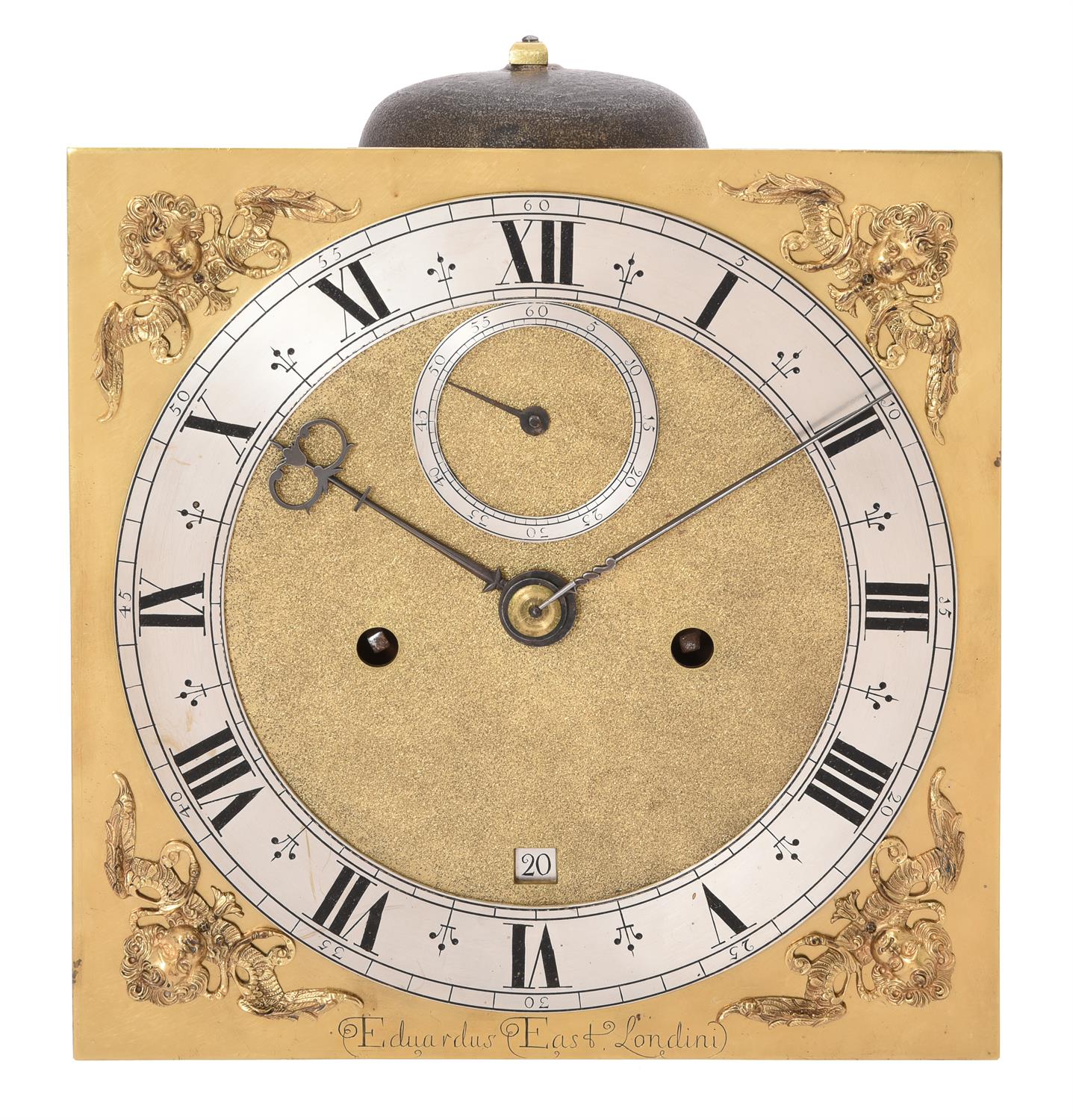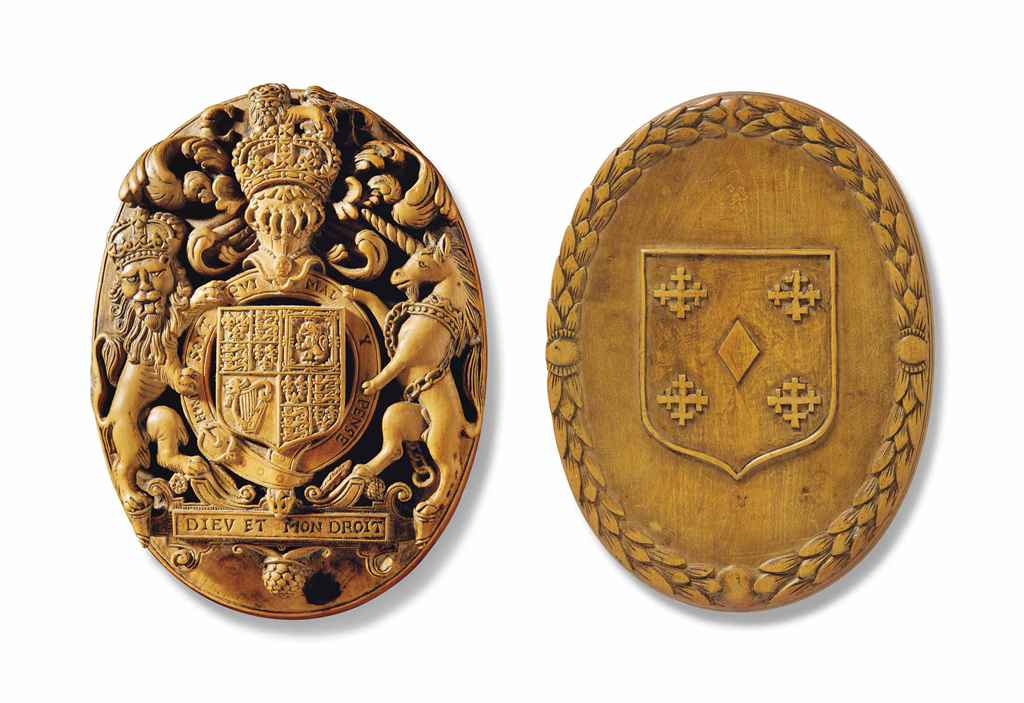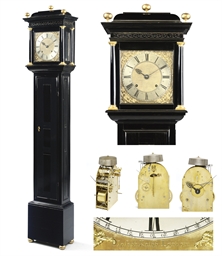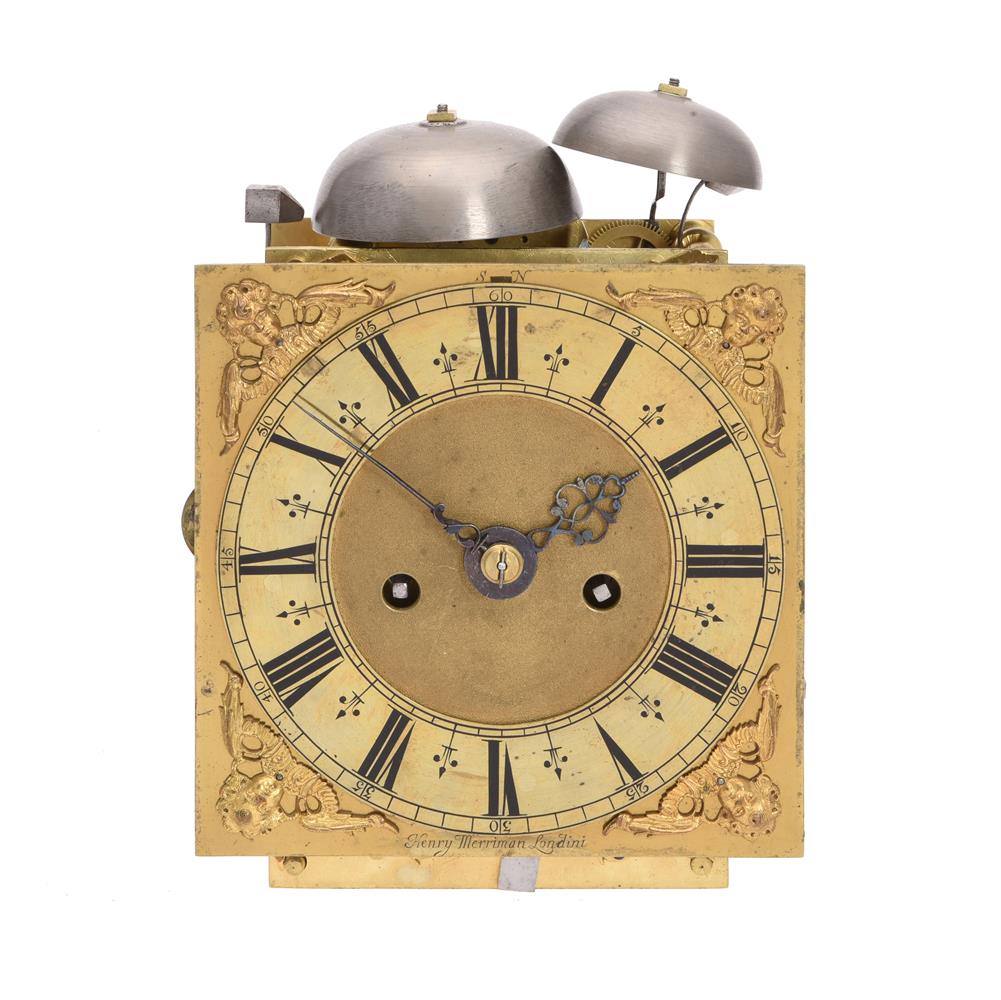A fine Charles II eight-day longcase clock movement with 10 inch dial and alarm The dial signed for Joseph Knibb London, circa 1680 The six knopped, finned and latched pillar movement with rectangular plates measuring approximately 7.5 by 5.125 inches, the going train regulated by anchor escapement for a seconds period pendulum with separately cocked escapement pallet arbor and figure-of-eight shaped pallet aperture to the backplate, the strike train with external countwheel and detent for sounding the hours on a bell mounted above the plates, the alarm train planted between the plates above the going greatwheel with spring barrel wound through the dial against a ratchet with sprung pawl mounted on the backplate, driving via an intermediate wheel with locking hoop a vertical verge crownwheel for the alarm hammer arbor with looped brass head sounding on the hour bell above, the 10 inch square gilt brass dial with three winding holes and rose engraved alarm disc to the finely matted centre within applied 1.5 inch wide silvered Roman numeral chapter ring with stylised fleur-de-lys half hour markers and Arabic five minutes within the narrow outer track, the angles applied with winged cherub head spandrels within a line scribed border interrupted with engraved script Ioseph Knibb London to lower margin and with alarm locking lever to upper margin, (lacking pendulum, weights and seatboard). Joseph Knibb was born the fifth son of Thomas Knibb of Claydon, Oxfordshire in 1640. He is generally thought to have been apprenticed in around 1655 to his cousin Samuel Knibb in Newport Pagnell, before moving to Oxford circa 1662 (the same year that Samuel moved to London). Joseph initially struggled to trade in Oxford due to restrictions placed by the City authorities which were only relaxed on payment of a fine in 1668. It was about at this time that Joseph Knibb would have issued his copper trade tokens (an example of which was sold in these rooms 10th February 2009, lot 104 for £1,600 hammer) as well looking to undertake work to convert the turret clocks of St. Mary the Virgin and Wadham College to anchor escapement with long pendulum. In 1670 Joseph moved to London handing over the Oxford business to his younger brother, John. The reason for this move was probably to administer the estate of Samuel who is thought to have died by the summer of 1671. Joseph Knibb presumably took on Samuel's former workshop as by 1675 he was recorded as working from 'The Dyal' near Sargeants Inn in Fleet Street. By 1693 he had moved to 'The Clock Dyal' Suffolk Street, near Charing Cross. As Joseph became established in London his work became more individual/distinctive, often demonstrating an inventive and refined approach both in the detailing and specification of the movements and choice of case design. He is perhaps best known for his experimentation with alternative striking such as Dutch, Roman and double-six grande sonnerie as well as long duration clocks. In 1697 Joseph Knibb sold up the London business (presumably to Samual Aldworth, former apprentice of John Knibb of Oxford) and retired to Hanslop in Buckinghamshire where he died in December 1711. The current lot can be closely compared to the movement of a miniature eight-day longcase clock by Joseph Knibb housed in an oyster olivewood and marquetry case described and illustrated in Darken, Jeff (ed.) HOROLOGICAL MASTERWORKS pages 162-5. This movement shares the same slightly unusual casting for the pallet arbor cock (complete with wedge-shaped pivot end cap), figure-of-eight pallet aperture and pendulum suspension post riveted directly into the backplate. The wheel collets also match as does the detailing to the countwheel at the centre. Both the current lot and the miniature longcase movement also exhibit details typical of Joseph Knibb namely the lack of bridge for the hour wheel to the frontplate, slender pillars and relatively thin plates. In addition to the current lot and the miniature longca
A fine Charles II eight-day longcase clock movement with 10 inch dial and alarm The dial signed for Joseph Knibb London, circa 1680 The six knopped, finned and latched pillar movement with rectangular plates measuring approximately 7.5 by 5.125 inches, the going train regulated by anchor escapement for a seconds period pendulum with separately cocked escapement pallet arbor and figure-of-eight shaped pallet aperture to the backplate, the strike train with external countwheel and detent for sounding the hours on a bell mounted above the plates, the alarm train planted between the plates above the going greatwheel with spring barrel wound through the dial against a ratchet with sprung pawl mounted on the backplate, driving via an intermediate wheel with locking hoop a vertical verge crownwheel for the alarm hammer arbor with looped brass head sounding on the hour bell above, the 10 inch square gilt brass dial with three winding holes and rose engraved alarm disc to the finely matted centre within applied 1.5 inch wide silvered Roman numeral chapter ring with stylised fleur-de-lys half hour markers and Arabic five minutes within the narrow outer track, the angles applied with winged cherub head spandrels within a line scribed border interrupted with engraved script Ioseph Knibb London to lower margin and with alarm locking lever to upper margin, (lacking pendulum, weights and seatboard). Joseph Knibb was born the fifth son of Thomas Knibb of Claydon, Oxfordshire in 1640. He is generally thought to have been apprenticed in around 1655 to his cousin Samuel Knibb in Newport Pagnell, before moving to Oxford circa 1662 (the same year that Samuel moved to London). Joseph initially struggled to trade in Oxford due to restrictions placed by the City authorities which were only relaxed on payment of a fine in 1668. It was about at this time that Joseph Knibb would have issued his copper trade tokens (an example of which was sold in these rooms 10th February 2009, lot 104 for £1,600 hammer) as well looking to undertake work to convert the turret clocks of St. Mary the Virgin and Wadham College to anchor escapement with long pendulum. In 1670 Joseph moved to London handing over the Oxford business to his younger brother, John. The reason for this move was probably to administer the estate of Samuel who is thought to have died by the summer of 1671. Joseph Knibb presumably took on Samuel's former workshop as by 1675 he was recorded as working from 'The Dyal' near Sargeants Inn in Fleet Street. By 1693 he had moved to 'The Clock Dyal' Suffolk Street, near Charing Cross. As Joseph became established in London his work became more individual/distinctive, often demonstrating an inventive and refined approach both in the detailing and specification of the movements and choice of case design. He is perhaps best known for his experimentation with alternative striking such as Dutch, Roman and double-six grande sonnerie as well as long duration clocks. In 1697 Joseph Knibb sold up the London business (presumably to Samual Aldworth, former apprentice of John Knibb of Oxford) and retired to Hanslop in Buckinghamshire where he died in December 1711. The current lot can be closely compared to the movement of a miniature eight-day longcase clock by Joseph Knibb housed in an oyster olivewood and marquetry case described and illustrated in Darken, Jeff (ed.) HOROLOGICAL MASTERWORKS pages 162-5. This movement shares the same slightly unusual casting for the pallet arbor cock (complete with wedge-shaped pivot end cap), figure-of-eight pallet aperture and pendulum suspension post riveted directly into the backplate. The wheel collets also match as does the detailing to the countwheel at the centre. Both the current lot and the miniature longcase movement also exhibit details typical of Joseph Knibb namely the lack of bridge for the hour wheel to the frontplate, slender pillars and relatively thin plates. In addition to the current lot and the miniature longca















Testen Sie LotSearch und seine Premium-Features 7 Tage - ohne Kosten!
Lassen Sie sich automatisch über neue Objekte in kommenden Auktionen benachrichtigen.
Suchauftrag anlegen